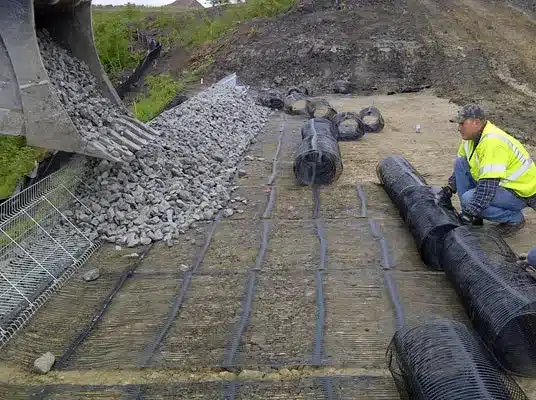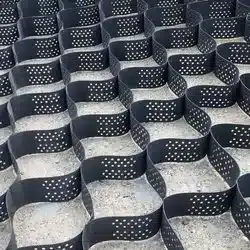+86-159 9860 6917
info@geofantex.com
geofantex@gmail.com
+86-400-8266163-44899
In the rapidly evolving world of construction and civil engineering, geosynthetics have emerged as a cornerstone for modern infrastructure projects, increasingly used as regular construction materials in transportation infrastructure construction. These synthetic products, employed alongside soil and other geotechnical materials, offer unparalleled benefits in terms of durability, cost-effectiveness, and environmental sustainability.

What are the uses of geosynthetics in construction?
Geosynthetics are used in a variety of ways in construction, including:
- Soil Reinforcement: They reinforce the soil by improving its tensile strength, thus preventing landslides and soil erosion.
- Drainage: Geosynthetics aid in effective water drainage, preventing waterlogging and soil degradation.
- Filtration: Acting as a filter, they allow water to pass through while preventing soil movement.
- Separation: They separate different layers of soil and materials, maintaining the integrity of roadbeds and foundations.
- Containment: Used in landfills and for hazardous waste containment, they prevent contamination of surrounding areas.
What are the five major functions of geosynthetics?
The five major functions of geosynthetics, encompassing separation, reinforcement, filtration, drainage, and moisture barrier, are essential in modern construction practices. These functions include:
- Separation: This involves preventing the mixing of different soil layers, and ensuring structural integrity.
- Reinforcement: This function enhances the mechanical properties of soil, contributing to the overall stability of the structure.
- Filtration: Geosynthetics allow for fluid passage while preventing soil erosion, and maintaining the balance between water flow and soil retention.
- Drainage: They play a crucial role in facilitating the removal of excess water or fluids, preventing waterlogging and related issues.
- Moisture Barrier (Protection): Acting as a moisture barrier, they provide a protective layer to shield geomembranes and other materials from damage, ensuring the longevity and durability of the infrastructure.

What are the most common geosynthetics?
- Geotextiles: Fabric-like materials used for filtration, separation, and reinforcement.
- Geomembranes: Impermeable membranes, including clay liners and geomembranes, are used primarily for containment.
- Geogrids: Grid-like structures used for soil reinforcement.
- Geonets: Net-like channels used for drainage.
- Geocells: 3D honeycomb-like structures used for erosion control and soil stabilization.
- Clay Liners: Often used in conjunction with geomembranes for environmental containment applications.
- Geocomposites: A combination of different geosynthetics, such as geotextiles and geonets, designed for multifunctional purposes.
How do geosynthetics contribute to environmental sustainability in infrastructure projects?
Geosynthetics play a significant role in promoting environmental sustainability:
- Erosion Control: They reduce soil erosion, protecting landscapes and ecosystems.
- Resource Efficiency: By reinforcing weaker materials, they reduce the need for natural resources like aggregate and sand.
- Carbon Footprint Reduction: Geosynthetics often require less energy to produce and transport compared to traditional materials.
- Water Management: Effective drainage and containment systems help in managing water resources and preventing contamination.
- Durability and Longevity: Infrastructure with geosynthetics tends to have a longer lifespan, reducing the frequency of repairs and replacements, thereby conserving resources and minimizing environmental impact.
In conclusion, geosynthetics are not just beneficial for infrastructure development but are also pivotal in advancing sustainable construction practices. Their diverse functions and applications underscore their importance in modern engineering and environmental conservation efforts.



Get Free Sample
We’ll respond as soon as possible(within 12 hours)






















